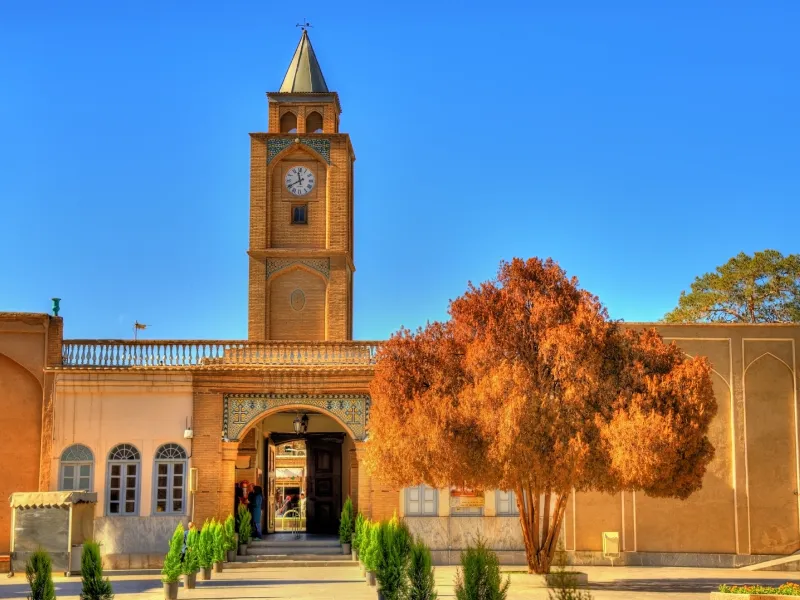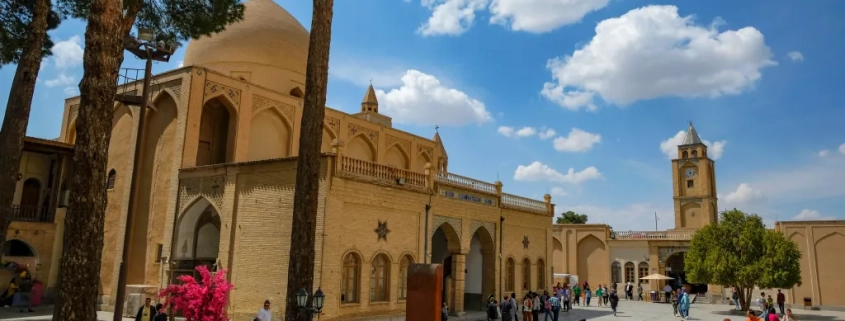Vank Cathedral, Isfahan (Paintings, Photos, Reviews)
Iran is home to several historically significant cathedrals, particularly those linked to its Armenian Christian community. A notable example includes the enthralling Vank Cathedral, also known as “The Holy Savior Cathedral,” in the city of Isfahan, which is known for its architecture and stunning frescoes. The Vank Cathedral is situated in the New Jolfa neighborhood. This Armenian Cathedral is renowned for its brilliant combination of Armenian and Persian architectural styles. It is inscribed in the list of UNESCO World Heritage Sites. It is a valuable gem that has an intriguing story behind its name, and not only does it have a historical and cultural place in the country, but it also has a special status for the Armenians living in Iran from a religious point of view. Let’s learn more about this cathedral as one of the top things to do in Isfahan!
About The Vank Cathedral
Vank Cathedral, or the Holy Savior Cathedral, is an iconic Armenian church in the Jolfa district of Isfahan, Iran. It is a prime example of Armenian architecture and artistry, blending traditional Persian elements with Western Christian styles. The cathedral features a stunning facade adorned with intricate tile work and an impressive dome. Inside the building, visitors can admire its beautiful frescoes and paintings, stained glass windows, and a richly decorated altar, all depicting biblical scenes and Armenian heritage.

Vank Cathedral also houses a museum that exhibits Armenian artifacts, manuscripts, and the history of the Armenian community in Iran, making it an important cultural and historical landmark. It serves as a symbol of the Armenian community’s rich history in Isfahan, particularly during the Safavid dynasty when many Armenians settled in the region.
The most distinguished feature of the Vank Cathedral that attracts its visitors is the outstanding works of art in the interior part of the building. Inside, you will find the works of great artists in every corner of the Vank Cathedral. The elegant and magnificent architecture, beautiful statues, colorful carvings, paintings, and historical paintings have enhanced the value of the cathedral. In the courtyard, there are tombstones of Armenian elders.
New Jolfa Neighborhood in Isfahan
Jolfa is the name of a city, half of which remained on the other side of the border of Iran in the south of the border river Aras. By the order of Shah Abbas Safavi, about 3 thousand people of Armenian descent from Jolfa of Aras were moved to Jolfa of Isfahan to work in the production and export of silk through the Persian Gulf.
Now, because of the Aras commercial-industrial free zone and the boom in tourism in this area, Jolfa has emerged as a destination for shopping and travel.
Vank Cathedral History
Vank Cathedral was built in the late 17th century, specifically between 1655 and 1664, during the reign of Shah Abbas II of the Safavid dynasty. The cathedral was constructed in the New Jolfa neighborhood of Isfahan, which was established to house the Armenian population that had been relocated from the region of Jolfa in present-day Armenia. This relocation aimed to unite the Armenian community and promote trade.

During the Safavid period in Iran, Shah Abbas I ordered the retreat of the Iranians during the war with the Ottomans. On their way back, the Iranian army passed through Armenia.
By the order of Shah Abbas I, many parts of the route were destroyed to prevent the advance of the Ottomans, and in the meantime, the Armenian people were in danger of mass slaughter. For this reason, Shah Abbas decided to bring Armenians to Iran and settle them.
Over time, Armenians planned to construct the Jolfa area and create various facilities for themselves, such as religious buildings for performing their religious duties.
The Vank cathedral was initially a small church called Jacob’s Church and was used by Christian clergy for 50 years. Many priests and caliphs were trained in the church during that era. Later, the church was developed and made into a sophisticated cathedral and named Vank. Vank means monastery in Armenian.
Vank Cathedral Architecture
Vank Cathedral showcases an architectural style that beautifully merges Armenian and Persian influences. The exterior features a typical Armenian dome with a cross at its apex, surrounded by intricate brickwork and striking tile mosaics. The facade is adorned with colorful tiles, blending floral and geometric patterns typical of Persian art.
Inside, the cathedral boasts a richly decorated interior filled with vibrant frescoes that depict biblical scenes, Armenian saints, and the Last Judgment, illustrating the fusion of Christian iconography with local artistic traditions.

When entering the Vank Cathedral, you can see a tall tower called the “First Bell Tower” or “Clock Tower”. This tower is built on three floors.
On top of this tower, you can see a very big clock. The weight of this watch is about 300 kg. Another bell tower of the cathedral is located on the roof, between the western wall and the small dome.
The second bell tower has a square shape, and its area reaches 8 square meters. The altar area has spectacular reredos and is complemented by ornate woodwork and elaborate chandeliers, enhancing the cathedral’s stunning aesthetic.
Vank Cathedral Paintings
Looking at the Vank Cathedral photos, you will see one of the most remarkable and dashing parts of Vank Cathedral, which are its paintings. The paintings at Vank Cathedral are famous for their vibrant colors and intricate detail, illustrating the special Armenian and Persian artistic styles.
The interior is adorned with frescoes that depict biblical scenes, including paintings of The Last Supper and depictions of hell and the abyss. Stories from the birth of Jesus Christ to his ascension from purgatory to heaven and hell can be seen in the aesthetic and colorful pictures on the walls and ceiling of the Vank Cathedral. Alongside these paintings, you can also see the representations of Armenian saints.
Notably, the ceiling features a striking portrayal of the heavenly realm, emphasizing the connection between divine and earthly realms.
The paintings in Vank Cathedral are some of the most exquisite examples of Armenian religious art, showing both biblical themes and the cultural fusion present in the region. These frescoes adorn the interior walls and ceilings, depicting scenes from both the Old and New Testaments, as well as saints and icons significant to Armenian Christianity.

The vibrant colors, intricate details, and stylistic elements blend Western artistic influences with traditional Persian motifs. The paintings not only serve a decorative purpose but also educate visitors about biblical stories and the heritage of the Armenian community in Isfahan, making them an essential aspect of the cathedral’s significance.
Vank Cathedral Location
Vank Cathedral is located in the Jolfa neighborhood in the center of Isfahan city and the south of Zayandeh Rud River. Today, the Jolfa area is known as New Jolfa and is one of the most stunning areas of Isfahan.
The new Jolfa area is now located in the center of Isfahan City, and the Vank Cathedral is also located north of the Jolfa neighborhood. This area is made up of eight neighborhoods. Jolfa neighborhood reaches Nazar Street from the north, Shariati West Street from the south, Towhid Street from the east, and Hakim Nezami Street from the west.
Depending on where you stay in Isfahan city, you can reach Vank Cathedral from all four main streets, but direct access to Cathedral Street is possible from Hakim Nizami Street.
A little further down the church street, you will see the walls around the landmark. Note that traveling by car in the Jolfa area has limitations due to the antiquity of the area. You can park your car in the surrounding streets.
Vank Cathedral Reviews
Vank Cathedral, located in Isfahan, Iran, is often praised for its stunning architecture and rich history, displaying an exceptional combination of Armenian and Persian ornamentations. Visitors frequently emphasize the intricate frescoes, detailed tile work, inscriptions, and the beautiful gardens surrounding the cathedral.

Many reviews mention the serene atmosphere and the informative displays that enhance the experience, although some suggest that the site can get crowded during peak tourist seasons. Overall, Vank Cathedral is regarded as a must-visit for those interested in art, history, and culture.
Final Word
Vank Cathedral is worth visiting for its remarkable blend of Christian and Persian architectural styles, which presents a valuable perspective on the cultural intersections in Iran. The cathedral’s stunning frescoes and intricate artworks provide insight into Armenian heritage and religious art, while the peaceful setting in Isfahan’s New Jolfa district enables you to have a pleasant visit.
Additionally, the adjacent museum houses fascinating artifacts and exhibits that narrate the history of the Armenian community in Iran, enhancing your overall experience. The Vank Cathedral is not only a significant spiritual site but also a key cultural landmark that encapsulates a rich historical story.
Are you planning to travel to Iran and looking for an Iran resort? Consider Matinabad Eco-resort.





Leave a Reply
Want to join the discussion?Feel free to contribute!